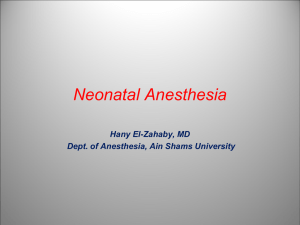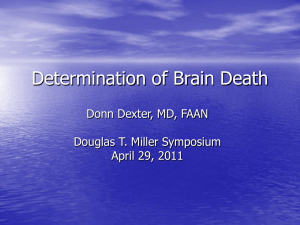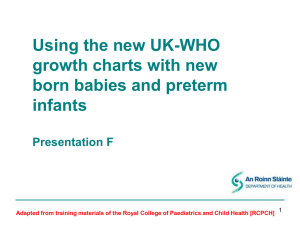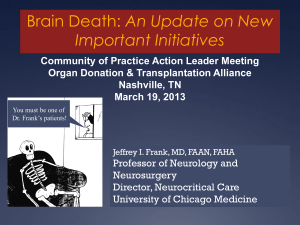Presentation
advertisement
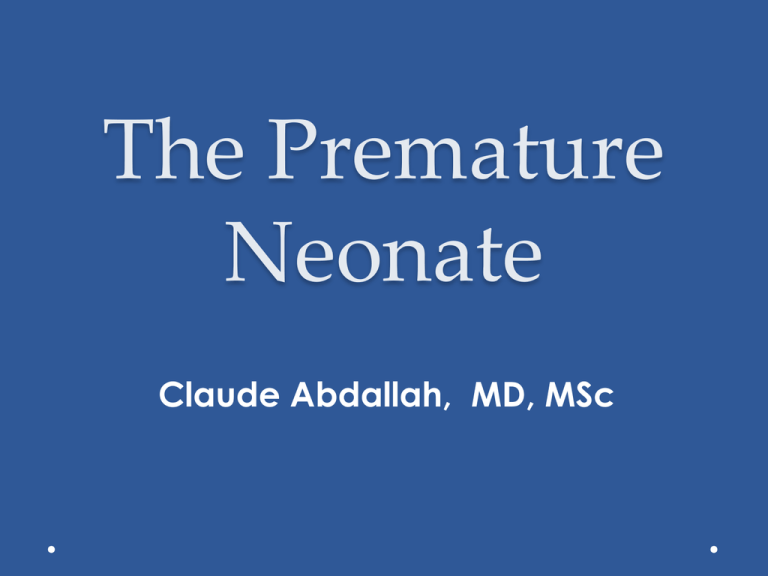
The Premature Neonate Claude Abdallah, MD, MSc Preterm Neonates • Morbidity and mortality in this population has decreased over the past 25 years. • In extremely low birth weight premature neonate(<1000 g): mortality < 50% (80% in 1980). • Contributing Factors: - Use of surfactant shortly after birth, - Specialization of neonatal care units, and - Changes in mechanical ventilator therapy. However, physiological challenges persist and affect the anesthesia management. Airway and Work of Breathing Spaeth JP, O'Hara IB, Kurth CD: Anesthesia for the micropremie. Semin Perinatol 1998; 22:390-401. Airway and Work of Breathing - Small airways : predispositon to obstruction and difficulty with ventilation. - Insertion of an ETT increases resistance and work of breathing far greater for the premie (2.5 or 3 mm inside diameter [ID]): (Resistance to airflow is inversely proportional to the fifth power for large airways and to the fourth power of the radius for small airways. ) - Additional partial occlusion from loss of muscle tone during anesthesia. Pediatr Crit Care Med. 2009;10(1):1-11. Effect of airway pathology • Subglottic stenosis, • Tracheal stenosis, • and Tracheobronchomalacia occur commonly in the micropremie increase further resistance to airflow and work of breathing. • Also, may necessitate the placement of even a smaller ETT>> airway resistance from the stenosis distal to the endotracheal tube POSTNATAL DEVELOPMENT OF THE LUNGS AND THORAX • The respiratory system is not fully developed at birth. • The morphologic and physiologic development of the lungs continues throughout the first years of life. • Alveolar formation begins only about the 36th week of gestation. • Thick-walled saccular spaces decrease lung compliance. Production of Surfactant -Begins between 23 to 24 weeks of gestation, -Remain inadequate until 36 weeks of gestation lung volumes and compliance are decreased increase intrapulmonary shunt and ventilation/perfusion mismatch and increase the risk of hypoxia. -Anesthesia further decreases V/Q mismatch. Ventilation with continuous PEEP during anesthesia required but limited: Susceptibility to O2 toxicity, barotrauma, and development of bronchopulmonary dysplasia. RAPID DESATURATION IN PREMIES?WHY? - Lung volume disproportionately small -Higher metabolic rates in infants: The neonatal oxygen consumption is approximately 6 ml/kg/min versus 3 ml/kg/min in the adult • Even under normal circumstances the immature cardiac and respiratory systems must function near maximum to support this metabolic demand. -Elastic recoil pressure of the lung and thorax are low • Poorly developed thoracic muscle mass • Increasing respiratory rate rather than tidal volume • The diaphragm is the primary respiratory muscle – has fewer highoxidative muscle fibers and is less resistant to fatigue than the adult diaphragm. • Mechanical challenge: Ribs “Raised” small increase in thoracic cavity volume with contraction of the diaphragm. , Respiratory Control and Prematurity Response to hypoxia: Biphasic Ventilatory Response - Initially, ventilation increases during hypoxia, but after several minutes, - Ventilation decreases and apnea may ensue. Anesthetic drugs: - depress the ventilatory responses to both hypoxia and hypercapnia. Anesthesiology 59:495-498, 1983 Editorial Life-threatening Perioperative Apnea in the Ex-”premie” George A. Gregory and David Steward Post anesthetic Care & Discharge of Neonates • Full Term Infant (Born at PCA* ≥ 37 weeks) and otherwise healthy: • If ≤ 45 weeks PCA: Overnight stay in hospital in monitored bed. • Must have at least 12 hours of apnea-free period prior to discharge. • Preterm Infant (Born at PCA <37 weeks) and otherwise healthy: • If ≤ 55 weeks PCA: Overnight stay in hospital in monitored bed. • Must have at least 12 hours of apnea-free period prior to discharge. Ex-premature infants should not undergo anesthesia for elective surgery until they are at least 56 weeks of PCA and Hct > 30%. A minimal stay of 2 hours of apnea free period in PACU is required for all these patients. If needed, they should be transported with monitoring and accompanied by a registered nurse. Kurth et al, 1987 Prospective study using pneumography 47 premature infants 37% incidence of postop. prolonged apnea in infants 32 - 55 wks. PCA Initial episode may occur as late as 12 hrs. postop. All types of surgical procedures, including NEC and VP shunts How about caffeine? Incidence of Perioperative Apnea and PB: Caffeine 5mg/kg Caffeine Postop. prolonged apnea none with bradycardia Postop. PB none Controls 8(73%)* 2(18%) Postop. apnea < 15 sec 8(89%) 1(9%) Postop. caffeine level mg/L (range) 5-8.6 zero Periodic Breathing •Three or more periods of apnea 3-15 secs. separated by < 20 secs. of normal respiration Incidence of Postoperative Apnea, PB and Desaturation: Caffeine 10mg/kg Caffeine Postop. prolonged apnea none Postop. PB >1% none Postop. desat.< 90% none Postop. caffeine level mg/L (range) 15-19 Controls 13(8%)* 4(25%) 8(50%) zero • Caffeine concentrations as low as 3-5 mg/L can decrease apneic spells in neonates, Brief apnea persisted • Plasma concentrations of 8-20 mg/L are required for optimal response • No toxicity(????) with concentrations as high as 50 mg/L Survival without disability to age 5 years after neonatal caffeine therapy for apnea of prematurity. JAMA. 2012 Jan 18;307(3):275-82. • Five-year follow-up in academic hospitals. Randomized, placebo-controlled. Caffeine for Apnea of Prematurity Study. A total of 1640 children with birth weights of 500 to 1250 g. • The combined outcome of death or disability was not significantly different for the 833 children assigned to caffeine from that for the 807 children assigned to placebo. Postoperative Apnea in Former Preterm Infants Spinal vs General Anesthesia Incidence of Postoperative Apnea and PB General Anesthesia Prolonged Apnea with bradycardia 5(31%) PB > 1% 1 Intubation or ventilation 0 Spinal Spinal + Anesthesia Ketamine 0 8(89%)* 0 2 0 0 Is Preoperative Transfusion Necessary? Postoperative Complications Hct > 30% Brief Apnea 0 Hct < 30% 0 PB > 1% 0 20% Prolonged Apnea 21% 80%* Bradycardia 0 20% Summary • Anemia in preterm infants increased incidence of postop. apnea • Anemic infants had high HbF and low 2,3 DPG • Defer elective surgery • Close postoperative monitoring Anesthesiology 82:809-822, 1995 Postoperative Apnea in Former Preterm Infants after Inguinal Herniorrhaphy Metanalysis of previous studies Limitations: Small number of patients Significant variation of incidence of apnea between different institutions Considerable variation in the duration and type of monitoring and definitions of apnea Predicted probability of apnea after leaving recovery room by weeks postconceptual age (weeks) for infants who did not have apnea in recovery room or anemia . Bottom marks indicate the number of data points by postconceptual age. The risk does not fall below 1% with 95% statistical confidence until 56 weeks postconceptual age. Anesthesiology. 82(4):809-822, April 1995. Fisher D Anesthesiology 82:807-808,1995 “.....Establishing policy regarding the postop. management of expremature infants undergoing inguinal hernia repair requires a decision regarding acceptable risk” Pediatric Anesthesia 22 (2012) 1139-1141 Thermoregulation & Premature Neonate Small size and Increased surface-area-to-volume ratio. Increased thermal conductance . Limited range of the neutral thermal environment= Range of ambient temp. at which metabolic rate is minimal. Normal body temp. range for a neonate is 36.5 to 37.7 °C. Temp. below 36 °C are considered hypothermic. Predisposition to APNEA, BRADYCARDIA, and/or METABOLIC ACIDOSIS. Maximum ventilatory response to PCO2 decreases. Extubation and Transfer Criteria Non Shivering Thermogenesis -Principally metabolism of brown fat (2-6% of TBW). -Brown fat differentiates at the 26 to 30 weeks gestational period. -Multinucleated cells, numerous mitochondria. -Abundant vascular supply and innervation. -COST: increases in norepinephrine (3X), glucocorticoids and thyroxine production. Prevention of hypothermia is extremely important Thermoregulatory Thresholds The intersection of line with the temp scale: threshold. Interthreshold range: Core temperatures not triggering autonomic thermoregulatory responses: 0.2-0.4 deg. C ASessler DI: Temperature monitoring. In Miller RD (ed): Anesthesia, 4th ed. New York, Churchill Livingstone, 1994, p 1363. Effects of Mild Hypothermia - Stress response: V-C (incr. SVR, CVP). - Decreased RBF and GF. Cold diuresis, impaired sodium reabsorption = hypovolemia. - Impaired coagulation: Defect in platelet fction & clotting factors. - Leftward shift of oxy-Hb dissociation curve + BMR= deleterious effect. - Increased wound infections (immune function & v-c). Duration of hosp. by 20%. - Shivering: Increase in wound pain and in intraocular and intracranial pressures. Effects of Anesthesia Medications on Thermoregulation • Volatile anesthetics: Hypothalamus + direct vasodilatory effect. Inhibit brown fat thermogenesis. Dose-dependent. • Opioids: reduce vasoconstriction. • Barbiturates: peripheral vasodilation. • Ketamine : less thermoregulatory effect. • Muscle relaxants: prevent shivering thermogenesis by effect on muscle tone. Pharmacological Effects of Hypothermia • Decreased hepatic & renal blood flow & metabolism =Prolongation of drug effects. • Protein binding increases as body temperature decreases. • The MAC of inhalational agents is 5-7% per 1C in core temp, but no change in speed of inhalational induction. • Prolong the duration of neuromuscular blocking agents. • Delays discharge from PACU and may prolong the need for mechanical ventilation. Cycle resulting from cooling in the neonate. (From Klaus M and Fanaroff A: Care of the high-risk neonate, ed. 3, Philadelphia, WB Saunders Co.) Covering the infant’s head with plastic wrap can greatly reduce the evaporative heat loss. During maxillofacial surgery, rectal temp. increased in infants given forced-air but remained nearly constant in patients warmed with circulating-water. (From Kurz et al. Anesth Analg 77:89, 93). Anesthetics and the Immature Brain • • Of particular concern are the reports in immature rats showing that prolonged exposure to isoflurane, ketamine, or midazolam …precipitates apoptosis in many regions of the brain. Attributed to the neurotransmitters glutamate and γ-aminobutyric acid, which act as trophic factors in the developing brain • Based on the life cycle of the rat compared with the human, the 4-day, 7-day, 10-day, and 14-day postnatal age rat corresponds to 28-week gestation, 32-week gestation, 40week gestation, and 55-week postconceptual age human. • Prolonged exposure at very high concentrations. • Potential for neurotoxicity from inhaled anesthetics, midazolam, and ketamine.. may be greater in preterm infants than full-term infants, although there is no evidence that similar neurotoxicity occurs in humans at any age exposed to any anesthetics. Arguments- Drug Dose • Anesthetic requirements for injectable agents much higher in small animals • • • Propofol 100x Ketamine 10x Higher doses led to much higher blood levels Prematurity & Cardiovascular System Greater risk of cardiovascular collapse during anesthesia: Structural: More connective tissue, less organized contractile elements Increased dependence on extracellular calcium concentration. Less compliant fetal heart has a flatter Frank-Starling curve Less sensitive to catecholamines because of near-maximal baseline βadrenergic stimulation. • Cardiac output depends more on heart rate in the premature than the full term neonate. The high resting heart rate in the premature does not permit cardiac output to increase to the same extent as full term. • • • • • Prematurity and Circulation • Small absolute blood volumelittle blood loss during surgery can cause hypovolemia, and shock. • Autoregulation is not well developed in the premie, heart rate may not increase with hypovolemia blood flow and oxygen delivery to the brain and heart may decrease with little blood loss.[ • Anesthesia blunts baroreflexes in the micropremie, further limiting the ability to compensate for hypovolemiapredispose the micropremie to cardiovascular collapse during major surgery. Circulating Blood Volume in Micropremature Infants, Premature Infants, Full-Term Neonates, Infants, and Children Micropremie Premie Full-term neonate Infant Child Blood Volume (mL/kg) 110 100 90 80 70 Weight (kg) 1 1.75 3 Total Blood Volume (mL) 110 175 270 25 mL Blood Loss Percentage Total Blood Volume (%) 23 14 9 10 20 800 1400 3 2 Neurologic Development • • • • • The impact of premature birth on the central nervous system (CNS) depends on gestational age at birth and the severity of cardiovascular, respiratory, and other postnatal stressors. The area of the brain most susceptible to injury in the micropremie is the periventricular white matter. The white matter consists of preoligodendrocytes, astrocytes, and neuronal axons. Late in the second trimester (24–27 weeks' gestation), preoligodendrocytes and astrocytes multiply tremendously and most cortical and subcortical structures begin to develop. The periventricular white matter is a “watershed region” and sus-ceptible to poor perfusion and hypoxic-ischemic injury during conditions of hypotension, low cardiac output, hypoxemia, and hypocarbia. Intraventricular Hemorrhage Premature neonates are more likely to exhibit severe long-term neurocognitive sequelae, Risk factors include fetal distress, vaginal delivery, low APGAR scores, metabolic acidosis, hypercapnia, and the need for mechanical ventilation. Respiratory distress syndrome, seizures, pneumothoraces, hypoxemia, acidosis, severe hypocarbia, and the use of vasopressor infusions. Rapid fluctuations in cerebral blood flow, cerebral blood volume, and cerebral venous pressure appear to play a role in the development of IVH .Factors that may decrease the incidence and severity of IVH include administration of sedation with opioids, antenatal glucocorticoids, or indomethacin Grade 1: hemorrhage limited to the germinal matrix Grade 2: hemorrhage extending into the ventricular system Grade 3: hemorrhage into the ventricular system and with ventricular dilatation Grade 4: hemorrhage extending into brain parenchyma. Retinopathy of Prematurity • Occurs in approximately 50% of extremely low birth weight infants, with the incidence being inversely proportional to birth weight and gestational age. • Variations in arterial oxygenation (hypoxia or hyperoxia) and exposure to bright light appear to play a role. • During anesthesia, we use the lowest inspired oxygen concentration that provides oxygen saturations between 92% and 96% and strive to avoid significant fluctuations in oxygen saturations. Renal and Metabolic Function • • • • • Glomeruli continue to form postnatally until approximately 40 days Fewer nephrons and smaller glomerular size, low cardiac output, hypotension, and nephrotoxic drugs may inhibit glomerular growth and development. Baseline plasma creatinine levels are higher with increasing prematurity and remain elevated until 3 weeks of age.[ Susceptibility to hyponatremia because of reduced proximal tubular reabsorption of sodium and water and reduced receptors for hormones that influence tubular sodium transport. Plasma potassium concentration occurs in preterm infants and results from a shift in potassium from the intracellular to extracellular space. Greater with decreasing gestational age and birth weight. Low cardiac output and urine output may further increase serum potassium concentrations and predispose to cardiac arrhythmias. Glucose Regulation • The micropremie is at risk for hypoglycemia as well as hyperglycemia. Decreased glycogen and body fat predispose to fasting hypoglycemia, whereas decreased insulin production with infusion of dextrose predisposes to hyperglycemia.[42,][43] Glucose production is poorly regulated within a large range of glucose and insulin concentrations. The micropremie is also relatively insulin resistant and requires a higher insulin infusion rate to reach normoglycemia.[44] The use of total parenteral nutrition and glucocorticoids places them at high risk for hyperglycemia. Glucose and the Brain • Hyperglycemia in neonates appears to protect the brain from ischemic damage. Strikingly different outcome between neonates and adults. • Relatively mild hypoglycemia is known to cause brain damage in preterm infants: Limited stores of glucose and consume glucose anaerobically. • Administration of dextrose-containing fluids and close monitoring of blood glucose levels is vital during anesthesia. • Mild or moderate hyperglycemia during surgery is best managed by reducing the rate of infusion of dextrosecontaining solutions and not administering insulin. Hepatic and Hematologic Function • Immature hepatic function • • Reduced albumin synthesis enhancing the “free” concentration of anesthetic drugs . Particular risk for spontaneous liver hemorrhage: during laparotomy for necrotizing enterocolitis (NEC), is associated with large intravenous fluid resuscitation, and is difficult to control surgically. • The ideal hematocrit level : controversial. Ht : 44% to 48%. • Liberal vs restrictive transfusion group: Restrictive transfusion group had a higher incidence of intraparenchymal brain hemorrhage, periventricular leukomalacia, and episodes of apnea. • The risks of blood transfusion should be weighed against the benefits of improved oxygen delivery and fewer medical complications. • Thrombocytopenia (<150,000/mm3) occurs frequently (70% of micropremature infants.) (sepsis, disseminated intravascular coagulation, and NEC are common causes.) Preoperative evaluation : include a recent platelet count for major procedures. Inhaled Agents MAC in the micropremie is considerably less than in full-term infants LeDez KM, Lerman J: The minimum alveolar concentration [MAC] of isoflurane in preterm neonates. Anesthesiology 1987; 67:301-307. Intravenous Agents • Half-life and clearance of fentanyl and morphine are increased. Thus, for a given dose of fentanyl, higher plasma fentanyl concentrations and a slower clearance of the drug will occur in the micropremie, which serves to prolong analgesia as well as prolong respiratory depression. • Thiopental is that it depresses cardiac output and causes venodilation and may precipitate cardiovascular collapse in the setting of hypovolemia; it also has a very long half-life in preterm and term infants. • Recovery from propofol anesthesia is slower in micropremies compared with term infants because they have less fat and muscle tissue to redistribute the drug. • Benzodiazepines are eliminated by the liver and thus can last several hours in the micropremie with decreased liver function. Arguments- Drug Dose • MAC of isoflurane in infant mice is 2.26% • Jevtovic-Todorovic et al showed significant neurodegeneration with 0.75%(0.33 MAC) Arguments - Lifespan • Humans have a more prolonged synaptogenesis period • May require much longer exposure for significant apoptosis
